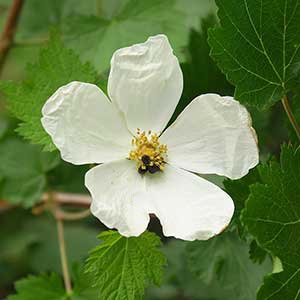Rubus bartonianus
Rubus pascuus
Barton's raspberry, bartonberry
Chesapeake blackberry, Nanticoke blackberry, topsy
erect, sparsely short-hairy, glabrescent, eglandular, not pruinose.
biennial, arching, sparsely to densely hairy, sparsely to densely sessile-glandular, rarely short-stipitate-glandular, not pruinose;
bark not papery, peeling;
prickles moderate to dense, hooked, retrorse, or erect, stout, 4–10 mm, broad- or narrow-based.
deciduous, simple;
stipules lanceolate, 4–6 mm;
blade cordate to broadly ovate, (2–)2.5–4(–5) × (2.5–)3.5–4.5(–5.5) cm, base deeply cordate, 3–5-lobed, lobe apices acute to obtuse, margins coarsely doubly dentate, abaxial surfaces glabrous or sparsely hairy, eglandular or sparsely stipitate-glandular.
deciduous to semievergreen, palmately compound, rarely ternate;
stipules filiform to linear, rarely narrowly lanceolate, 5–16(–20) mm;
leaflets 3–5, terminal broadly elliptic or ovate, (3.5–)4.5–8.5 × 2.5–6 cm, base rounded, unlobed, margins moderately to coarsely doubly, rarely singly, serrate, apex acute or short-acuminate, abaxial surfaces with hooked prickles on larger veins, short-velutinous to tomentose, sparsely to densely sessile-glandular, rarely short-stipitate-glandular.
1-flowered.
terminal and axillary, 3–15(–25)-flowered, cymiform to thyrsiform, not projected well beyond subtending leaves.
moderately hairy, eglandular or sparsely stipitate-glandular.
prickles moderate to dense, hooked, retrorse, or erect, densely hairy, eglandular or sparsely to moderately sessile-glandular.
bisexual;
petals white, obovate, (15–)20–25 mm;
filaments filiform;
ovaries glabrous, styles clavate, villous.
bisexual;
petals white to pale pink, obovate or elliptic to orbiculate, (8–)10–15 mm;
filaments filiform;
ovaries glabrous or apically hairy.
deep red, hemispheric, to 1 cm;
drupelets 10–30, coherent, separating from torus.
black, globose to subcylindric, 1–2 cm;
drupelets (15–)20–40(–50), strongly coherent, separating with torus attached.
= 21, 28.
Rubus bartonianus
Rubus pascuus
Of conservation concern.
Rubus bartonianus is distinguished from the other flowering raspberries within its geographic range by its erect, unarmed stems, relatively small, simple leaves with acute to obtuse lobes, deeply cordate bases, sparsely hairy or glabrous abaxial surfaces, relatively large flowers with white petals, and densely long-hairy, clavate styles. The leaves superficially resemble those of Acer glabrum or some species of Ribes.
Rubus bartonianus is most similar to R. neomexicanus but especially R. deliciosus. The species is known only from the Snake River Canyon of Idaho and Oregon.
(Discussion copyrighted by Flora of North America; reprinted with permission.)
Rubus pascuus is probably more widespread than indicated here. The species is most likely to be mistaken for R. bifrons, R. cuneifolius, or R. pensilvanicus. Unlike R. bifrons, R. pascuus is generally more densely glandular, has much shorter, compact inflorescences that usually barely surpass the leaves, and tends to hold its primocane leaves relatively erect (versus spreading in R. bifrons). Although both can be semievergreen, R. pascuus will lose its leaves more readily than R. bifrons in areas where they co-occur. When compared with R. cuneifolius, R. pascuus has pale pink to white petals and ovate to broadly elliptic leaflets with flat margins, the entire part restricted to the base; R. cuneifolius has white petals and cuneate to obovate leaflets with usually revolute margins, the proximal third entire. When compared with R. pensilvanicus, R. pascuus has pale pink to white petals. Rubus pensilvanicus only has white petals as well as abaxial leaf surfaces, which are white to gray-green in R. pascuus with dense, short-velutinous to tomentose indument, while those of R. pensilvanicus can be hairy but never whitish to gray-green. A notable aspect of R. pascuus is how vigorously armed it is, more so than most other Rubus species in the flora area.
Rubus pascuus may represent a stabilized hybrid between a European and a native blackberry species, suggested by whitish pubescence on the abaxial leaf surface and pale pink petals. L. H. Bailey placed R. pascuus in his sect. Cuneifolii (L. H. Bailey) L. H. Bailey, likely because of the whitish hairs on the abaxial leaf surface.
The use of the name Rubus pascuus here is tentative; it is the best fit to the material observed. This treatment follows H. A. Davis (1990) for the choice of the name to use and its associated synonymy.
(Discussion copyrighted by Flora of North America; reprinted with permission.)


